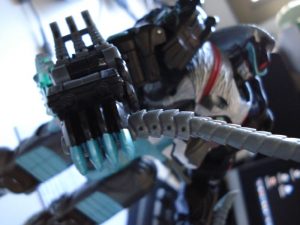By Jacob Parakilas

For better or worse, science fiction and military futurism are deeply interlinked. Science fiction films and novels have proliferated throughout military recommended reading lists, influenced naming conventions and military symbolism, and contributed to a budding genre of fiction-as-informed-prediction.
But for every classic – for every “2001: A Space Odyssey” or “The Forever War” – there are dozens of more forgettable pieces of entertainment exploring the same themes.
Last night I watched one such film, “Outside the Wire,” a Netflix production. It was, I am sorry to report, not particularly good. Despite an overqualified cast and some halfway respectable special effects, the character motivations were inconsistent, the dialogue was clunky, and the plot descended quickly into incoherence, partly due to some fairly serious misunderstandings of how the military chain of command, robotics, and nuclear weapons work.
This hasn’t suddenly become a film review column; I’ll leave the parsing of Anthony Mackie’s portrayal of a mysterious combat android to the professionals. And it is worth acknowledging that mass-market film and TV are designed for the mass market; the vast majority of the audience won’t have their enjoyment of a film degraded by the nagging defense-analyst voice in their mind (or in my wife’s case, on the couch next to her) complaining loudly that a character who ought to know better just used the wrong name for the drone they’re flying.
But amidst the incoherence, the film contained some interesting concepts. For example, humanoid autonomous robot soldiers called “Gumps” are featured prominently. The film, set in 2036, makes a reasonable set of guesses as to how such robots would look, what roles they would take on a battlefield and how human soldiers might react to their presence (unhappily, for the most part). At one point – minor spoilers ahead – a squad of American Gumps confronts a group of Russian-backed militiamen with hostages and their own set of Gump-equivalents on the steps of a Ukrainian bank. The protagonist, trying to de-escalate the situation, begs the American robots not to “pre-empt” – but one of the robots gets a clear line of fire to the militia leader and shoots him without warning, leading to catastrophically bloody results.
Notwithstanding the film’s numerous other inaccuracies, this scene efficiently depicts a huge set of issues with the use of autonomous weapons in combat. The American Gumps fail to communicate anything aside from menace to the hostage takers, which cuts off any real avenue for de-escalation or peaceful resolution. The robots are depicted as working effectively as a unit and having some mechanism to distinguish between hostile combatants and non-combatants, but once the shooting starts most of the hostages are killed in the crossfire anyway (not that their human commanders are shown to have much concern for collateral damage either). It gets lost in the film’s muddled overall politics, but the distance between the apparent kinetic effectiveness of the Gumps and their broader failures could be read as an indictment of the technological-military complex and its growing focus on automation and overwhelming firepower as the solution to any tactical or strategic problem.
Why bother analyzing an action scene in a mid-budget Netflix film? Partly because art imitates life: as military robotics become more common and widely distributed, narratives featuring them move from the outer reaches of science fiction into near-future speculative forms that border on real-world thrillers. From a defense analytical perspective, it is valuable to see what themes and messages make it through from the world of policy papers and test articles out into the broader world of people who don’t spend their time reading the after-action reports of simulated battles.
But the more significant reason to look at these depictions is that life imitates art. Mass media shapes how warfare is perceived by a growing section of the population, and not only in the U.S., where the distance between the military-adjacent (service personnel, veterans, and their families) and non-military-adjacent populations is growing. Most major powers, including China and Russia, are also downsizing, professionalizing, and automating their militaries, resulting in a similar dynamic. That extends not just to voting publics but to figures in leadership, who are increasingly unlikely to have personally experienced combat and whose imagery of it will accordingly be shaped to a greater degree by dramatic portrayals.
So, to the extent that such media can communicate nuanced messages about the employment of armed force, rather than simplistic narratives of victory through overwhelming technological firepower, it should be encouraged – even, or perhaps especially, if those narratives are unlikely to make critics’ Best Of lists at year’s end.
No comments:
Post a Comment